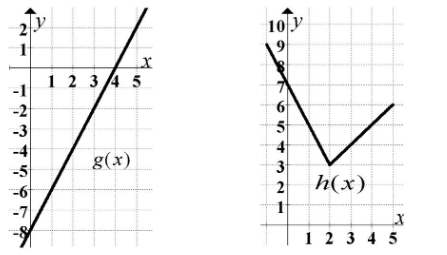Use the graphs to answer the next series of questions. Note that h has a sharp corner at x = 2. 2 y 21 X 1 2 3 4 5 f g(x) -7 -1 -2 12. If f(x) = g(x) h(x), find... a. f'(0) . b. f'(2) 10 y 4 3 2 1 h(x) X 1 2 3 4 5 c. f'(4)
Use the graphs to answer the next series of questions. Note that h has a sharp corner at x = 2. 2 y 21 X 1 2 3 4 5 f g(x) -7 -1 -2 12. If f(x) = g(x) h(x), find... a. f'(0) . b. f'(2) 10 y 4 3 2 1 h(x) X 1 2 3 4 5 c. f'(4)
Calculus: Early Transcendentals
8th Edition
ISBN:9781285741550
Author:James Stewart
Publisher:James Stewart
Chapter1: Functions And Models
Section: Chapter Questions
Problem 1RCC: (a) What is a function? What are its domain and range? (b) What is the graph of a function? (c) How...
Related questions
Question

Transcribed Image Text:## Analysis of Graphs and Calculus Problems
The provided graphs and questions are designed to test your understanding of derivatives and functions. Below is a detailed explanation of each element present in the graphs and questions.
### Graph Details
#### **Graph of \( g(x) \):**
- This graph features a straight line with a positive slope.
- The line passes through the x-y plane, specifically crossing the x-axis around 4.
- The y-intercept of the line is approximately -8.
- The slope of the line can be determined by analyzing the change in y over the change in x between any two points on the line.
#### **Graph of \( h(x) \):**
- This graph is characterized by two line segments forming a V-shape, indicating a piecewise linear function.
- The V-shape converges at the point \( (2, 3) \), which is a sharp corner.
- The line segment on the left has a negative slope while the right segment has a positive slope.
- Notably, the graph has a sharp corner at \( x = 2 \), indicating a point where the derivative does not exist.
### Questions and Calculations
#### **12. If \( f(x) = g(x) \cdot h(x) \), find…**
- **a. \( f'(0) \)**
- **b. \( f'(2) \)**
- **c. \( f'(4) \)**
This problem involves finding derivatives at specific points for the product of two functions. The Product Rule from calculus will be used here.
#### **13. If \( f(x) = \frac{g(x)}{h(x)} \), find…**
- **a. \( f'(0) \)**
- **b. \( f'(2) \)**
- **c. \( f'(4) \)**
This problem involves finding derivatives for the quotient of two functions, utilizing the Quotient Rule.
#### **14. If \( f(x) = \frac{h(x)}{g(x)} \), find…**
- **a. \( f'(0) \)**
- **b. \( f'(2) \)**
- **c. \( f'(4) \)**
Similar to question 13, this problem requires the use of the Quotient Rule for differentiation.
### Note:
For each of these questions, calculating the derivatives at the specific points
Expert Solution
Step 1: Define the problem.
Question no. (12)

If , then to find the following.
Note: Since the student has posted multiple questions and does not mention
any specific question, so we are solving first question (question no. 12) according to
our guidelines. Student can re-post the remaining questions.
Trending now
This is a popular solution!
Step by step
Solved in 6 steps with 30 images

Recommended textbooks for you

Calculus: Early Transcendentals
Calculus
ISBN:
9781285741550
Author:
James Stewart
Publisher:
Cengage Learning

Thomas' Calculus (14th Edition)
Calculus
ISBN:
9780134438986
Author:
Joel R. Hass, Christopher E. Heil, Maurice D. Weir
Publisher:
PEARSON

Calculus: Early Transcendentals (3rd Edition)
Calculus
ISBN:
9780134763644
Author:
William L. Briggs, Lyle Cochran, Bernard Gillett, Eric Schulz
Publisher:
PEARSON

Calculus: Early Transcendentals
Calculus
ISBN:
9781285741550
Author:
James Stewart
Publisher:
Cengage Learning

Thomas' Calculus (14th Edition)
Calculus
ISBN:
9780134438986
Author:
Joel R. Hass, Christopher E. Heil, Maurice D. Weir
Publisher:
PEARSON

Calculus: Early Transcendentals (3rd Edition)
Calculus
ISBN:
9780134763644
Author:
William L. Briggs, Lyle Cochran, Bernard Gillett, Eric Schulz
Publisher:
PEARSON

Calculus: Early Transcendentals
Calculus
ISBN:
9781319050740
Author:
Jon Rogawski, Colin Adams, Robert Franzosa
Publisher:
W. H. Freeman


Calculus: Early Transcendental Functions
Calculus
ISBN:
9781337552516
Author:
Ron Larson, Bruce H. Edwards
Publisher:
Cengage Learning